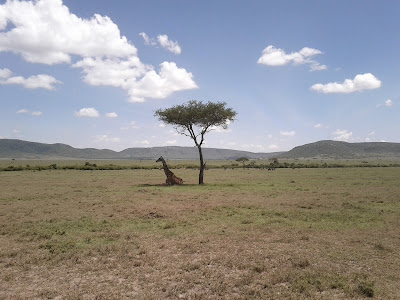We were really excited to have one of our friends and colleagues visit us for a few days in the field this past week. Frank Masese is an aquatic ecologist currently pursuing his PhD at UNESCO-IHE Institute for Water Education in The Netherlands. Frank is interested in organic matter inputs into the river, how they are processed by the river and its food web, and how these processes are altered by land use change. There are a lot of connections between his research and mine, and he's been a great colleague to have in the basin. He also knows a tremendous amount about aquatic macroinvertebrates, among many other things, so we took the opportunity of his visit to learn a lot from him about some of the critters we've been catching in the river of late.
The way we sample for bugs in the river is by using a kicknet. We hold the net in place in the river while we kick the river bottom upstream of the net, dislodging small insects that then float into the net.
 |
| Checking out our catch |
After you get the bugs in the net, you have to sort through a lot of other plant debris, sand, etc. to find and pick out the bugs.
 |
| Frank examining the net for bugs |
The bugs can be really small, and there's often a lot of dirt in the net, making this a pretty meticulous process.
 |
| Picking bugs out of the net |
The reward of all this sampling is a living story about the state of the river. Aquatic insects are important to the functioning of the river through breakdown of organic material and providing prey for larger animals. They also are great indicators of the river's health, because they are affected by physical and chemical changes in the water, they can't easily escape large changes, and different groups of insects are more or less sensitive to water quality. Just by looking at who is living in the river, you can learn a lot about how the water quality has been over the last few weeks.
Here are some mayflies we caught from the family Beatidae. Mayflies, in the order Ephemeroptera, are fairly sensitive to water quality. Baetidae are collector-gatherers that feed on plant detritus in the river. This is probably the most common family we catch, although there are many different species included in the family. In this picture, there are two different species of the same family.
 |
| Ephemeroptera Baetidae |
Here are some mayflies we caught from the family Tricorythidae, which are also collector-gatherers.
 |
| Ephemeroptera Tricorythidae |
This is another example of a mayfly, from the family Centroptiloides, but these guys are predators.
 |
| Ephemeroptera Centroptiloides |
We also found a few of these beautiful stoneflies, from the order Plecoptera, which are also highly sensitive to water quality. This individual is from the family Perlidae, and it is a collector-gatherer like the Baetidae and Tricorythidae.
 |
| Plecoptera Perlidae |
The third order known for being especially sensitive to water quality is Trichoptera, or the caddis-flies. Ephemeroptera, Plecoptera and Trichoptera are so well-known for their sensitivity to water quality that there's an index of aquatic health known as the % EPT index, or the % of insects captured from those 3 families. Here is a Hydropsychidae, which are filter feeders in the river.
 |
| Trichoptera Hydropsychidae |
Finally, we also caught a larval dragonfly, from the order Odonata. Odonates are also sensitive to water quality, but not as much as the EPT taxa. This one is from the family Gomphidae, and it is a predator.
 |
| Odonata Gomphidae |
It's a great sign about the river's health that we are catching so many sensitive species in the river this season. In fact, we are seeing some sensitive species at sites that we don't remember seeing before. I think the healthy flow levels over the past year have been great for the overall health of the river. Thanks so much to Frank for teaching us more about these river dwellers!

















































